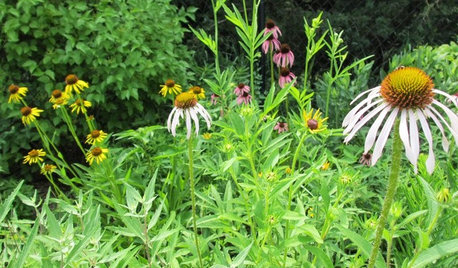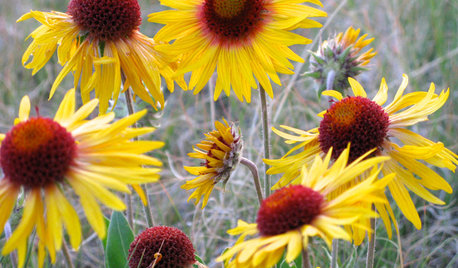Cut off all buds & blooms on young rose?
Someone told me that in order to direct the young plant's energy into the root strength, I should cut off all the flower buds and the 2-4 blooms that have burst forth, on my 2-year climbing antique roses. Is that right? It'd be a shame to not enjoy the sight and fragrance of my baby roses, after waiting 2 years. I read that the 3rd year, they "leap" and start growing taller. So far they are mostly 18" to 30" high. But they are all climbers: Alberic Barbier, r. alba semi-plena, Gardenia, Buff Beauty, Abraham Darby, r. moschata, Sombreuil, Crepuscule.
Carol
Comments (13)
michaelg
12 years agolast modified: 9 years agoNew growth usually starts 10-14 days after deadheading or removing buds at whatever stage; therefore, if you remove young flower buds, the plant will grow a little faster. However, I don't do that, and my impression is that most people don't. Certainly you want to see at least one bloom to confirm the plant's identity.
roseseek
12 years agolast modified: 9 years agoCarol, the theology behind the advice you received is this. A plant can either put energy into cane formation or flowering. IF the plant is one which won't grow, but flowers, such as Grey Pearl, Rosarium Uetersen, many Teas and Tea-Noisettes and others which will set flower buds INSTEAD of growth that enlarges the plant, to encourage the plant to develop to the size you desire, removing the flowers stimulates the plant to GROW to set more buds. None of the roses you listed are known to be of that type. The climbers will take up to three seasons (years) before they develop the root system necessary to support the large climbing growth you expect from them.
You MAY remove the buds to stimulate them to grow larger, quicker, but you don't have to. Now, if you were looking at Austin's Dove and lamenting it was such a runt, puny plant; or Duchesse d'Auerstadt and lamenting it was taking SO long for it to climb; or Rosarium Uetersen and complaining it was sitting like a small floribunda and flowering like a weed instead of climbing, I would suggest you disbud the plant for a summer, feed it well and force it to make wood instead of flowers. What you describe is not that. If you want flowers, enjoy flowers, but you haven't described anything which would suggest you would benefit from disbudding those plants. Kim
Related Professionals
Mitchellville Landscape Architects & Landscape Designers · Salem Landscape Architects & Landscape Designers · Simi Valley Landscape Architects & Landscape Designers · Hartford Landscape Contractors · Columbine Landscape Contractors · Downey Landscape Contractors · Estelle Landscape Contractors · Hannibal Landscape Contractors · Point Pleasant Landscape Contractors · Suitland Landscape Contractors · College Station Swimming Pool Builders · Grandview Swimming Pool Builders · Liberty Siding & Exteriors · Oak Park Siding & Exteriors · Weymouth Siding & Exteriorsingrid_vc so. CA zone 9
12 years agolast modified: 9 years agoKim, I must be dense but I haven't totally grasped your concept. Are you saying that climbers will take three years to grow into climbers whether you disbud or not? If so, I was under the impression that Rosarium Uetersen is also a climber but you suggest it as one that you should disbud for growth. I'm disbudding teas and Belinda's Dream in an area along a steep slope where I want fast growth but I'm also disbudding a tiny band of Cl. Lady Hillingdon in hopes of faster growth. Is the fact that it's a climber offset by its being a tea? I admit to some confusion here.
Ingrid
michaelg
12 years agolast modified: 9 years agoThere's a difference of degree among rose varieties as to how heavily they flower (vs the amount of vegetative growth) while still small. Kim is saying this difference could help you decide whether you want to disbud. Climbers could be in either class.
Climbers may make shrubby growth for a season or two (or three if from a tiny band) before they are strong enough to make multiple climbing shoots (> 7'). These shoots will be produced from the base rather than as extensions of shrubby canes.
meredith_e Z7b, Piedmont of NC, 1000' elevation
12 years agolast modified: 9 years agoI have a tiny band who has already tried to make at least 6 tiny little flowers. I let 2 open, saw it was who it was supposed to be, and I've been pinching off the rest!
I don't know if you have to on most bands, but I'm just not comfortable with them until they get taller than a few inches, lol.
The rose is a found noisette mix, btw. I don't know enough about it to know whether it has any vigor problems or whether it'll grow out of bounds very quickly :)
roseseek
12 years agolast modified: 9 years agoMichael is on the right track. Some roses, whether they are climbers or not, will flower at the expense of growth. Particularly, but NOT restricted to Rosarium Uetersen, Annie Laurie McDowell and some others. They flower instead of climbing. Many own root Teas, yellow Tea-Noisettes, older HTs which more closely resemble Teas in growth, some newer shrubs such as Austin's Dove and Fair Bianca, many of the earlier 'Coffee Roses' such as Grey Pearl, Fantan, Julia's Rose, etc.; the "weak" growers which take a longer time than you normally expect to develop the plant you desired, and those which aren't weak, but bloom instead of growing, will benefit from pinching flowering buds preventing them from blooming. Armstrong's Purple Tiger is a modern floribunda which greatly benefits from such treatment. It will bloom instead of growing, frequently nearly flowering itself to death. It exhausts itself flowering.
ANY rose can benefit from this treatment, even those which don't require it to develop the plant you want, as quickly as you hoped. The Teas and yellow Tea-Noisettes are weak, slow growers own root. Not that they can't or won't, it's that they take a whole lot longer than they do budded. Disbudding them will stimulate them to produce the genetically required wood quickly so they can flower and "perpetuate the species", which everything in Nature is genetically programmed to do before they die. Preventing them from flowering (ovulating), prevents them from potentially setting seed (pregnancy) and permits them, stimulates them into utilizing those resources they intended to use for reproduction for growth instead. This was all discussed in the thread "Can you push Teas?" just a few weeks ago.
Your plants don't necessarily need disbudding, but as has been posted above, doing it will cause them to GROW larger, faster. Small bands can be pushed into developing larger plants, faster with the treatment. Grey Pearl and Fantan, whether budded or not, REQUIRE the treatment to maintain them, period. Otherwise, they linger a while before just dwindling to nothing.
Yes, climbing roses generally require three years before they produce the climbing canes you bought them for. It will take ten feet of root before that plant throws ten feet of cane or top growth. Growing roots takes a while. Energy, food, "resources" are required for growth of canes and roots as well as blooming. If you don't let them bloom, they WILL utilize those resources for the other two, producing a larger plant, faster.
YOU are not dense, Ingrid! From what I have read and seen, you are quite intuitive in your rose growing. This is probably just a foreign concept we haven't explained properly enough for you to have your "Ah-ha!" moment! Belinda's Dream is, in my experience, a pretty fast, vigorous grower. It shouldn't require disbudding to give you the plant you desire in the time you expect it to.
Rosarium Uetersen can, and often does, just sit there like a floribunda and bloom its guts out. If you want it to climb faster, stop the flowering. "Push it" by not letting it bloom. Your Cl. Lady Hillingdon definitely will benefit from preventing her from blooming. She will grow significantly faster and climb in a much shorter period if you don't let her bloom, than she will allowing her to bloom. I'm not saying you CAN'T enjoy the flowers. I AM saying if you want the bigger plant faster, preventing them from flowering will give it to you. Giving the bands this treatment is a sure-fire way to get the larger plants you're more comfortable with quicker. It can help prevent you from losing them by stimulating them to develop into larger, more mature plants than they would have otherwise. Kim
aimeekitty
12 years agolast modified: 9 years agoso what classes would be most likely to require/benefit from this treatment?
All teas and yellow tea-noisettes? ... so ALL teas??
what else? Any rose that seems like it's not growing a lot?
Does this apply for portlands, DAs and Chinas, too?I just want to make sure I understand properly.
And how many years are you talking about having this sort of treatment? I did that to almost all of mine last year, their first year, but I was under the impression it wasn't necessary in the second year... should I start pinching for the rest of the year then on certain ones?
Some of my DAs like Mortimer Sackler, Jude the Obscure, Queen of Sweden (own root), Carding Mill (own root), William Shakespeare 2000 haven't grown all that much... so should I assume that if I pinch their blooms they might since they seem to be a bit weak?
Archduke Charles (china/bengale) has been blooming a lot but not growing all that much, but I've also heard it's a relatively slow grower.
How about Sombreuil? (the climbing floribunda one)
If a rose is already growing pretty strong, then should I assume I don't need to pinch it? or will it grow even better if I pinch it? some examples of strong growers in my case would be Mme. Berard, La France cl, James Galway cl, Alchemist, Mme Joseph Bonnaire (early hybrid tea)
ingrid_vc so. CA zone 9
12 years agolast modified: 9 years agoKim, I've bookmarked this thread because this is the clearest and most comprehensive discussion I've ever seen about disbudding and the rationale for it. You've answered all my questions, and more, and your story of trying to grow a giant climber quickly was fascinating, fun and again very informative.
Thank you so much for taking the time and trouble to explain all this to us. I'm sure that many of us can use this information to advantage. I know I will. You're the greatest!
Ingrid
annabeth
12 years agolast modified: 9 years agoThank you so much Roseseek and Michaelg for the very edifying replies. I am going to try this treatment on three of mine: a very young and small Gloire de Dijon, a very small but not so young Crepuscule, and a medium (floribunda-sized) Ghislaine de Feligonde.
G de F is blooming now but a litle past peak. It is going to be too hard for me to cut of all the blooms right now (meaning it will break my heart) so I think I'll wait until she finishes and then just keep her disbudded the rest of the season. I'll also FEED her better. I've given her nothing this spring yet. That's right, I said it. Nothing, zip, nada...I'm ashamed to say. I keep planning to but time slips by and while some other things get done, feeding the roses gets put on the back burner. And I can really tell. Your mention of feeding those nursery plants once a week with a quarter strength fertilizer was interesting but as I've not fed most of my roses even once yet, I don't know if I could hope to keep up that regimen. There was a similar suggestion on the dahlia forum recently where someone put it this way: feed "weekly, weakly". But summer vacation is here and things might not be so frantic and I can always start a weekly feeding schedule and adjust it back later to a longer interval.
Here's affirmation for you, Kim. Did you notice my problem children are all yellow, and two of them are tea-noisettes? Thanks again.
Annabeth
landperson
12 years agolast modified: 9 years agoHey, Kim, what would your "weak weekly" be comprised of if you were to be putting it together today?
roseseek
12 years agolast modified: 9 years agoYes ma'am, Annabeth. The yellow genes in Teas and the associated Tea-Noisettes produces some wonderful plants, but they can be SLOW right out of the gate and they HATE hard pruning. They, in particular, require all that stored food in the thick, old wood to explode into the growth you expect from them. It takes them what seems like an overly long time to create the roots and produce the wood they require. Add cooler temps, reduced sun, perhaps drainage issues and any disease or insect inhibitors and you have some real performance issues. Personally, while I love the idea of own root plants, for those types budding IS preferable because of the increased, artificial vigor the root stock adds to the mix. Even budded, they improve and benefit from the TPN treatment. Keeping them canned while you do it speeds things along greatly due to the increased cellular activity of warm roots and warmed sap, as well as the increased bacterial activity in warmer soil. From what I've read, most soil bacteria are fairly dormant in soil temps less than 70 degrees F, so the higher heat (as long as it isn't to the cooking levels) of canned roots helps push them even faster than when in the ground. That's also why standards on suitable stocks (read IXL where the sap flow is tremendous, as opposed to Huey, which is today's standard, and whose flow rate significantly slows as the trunks get longer), tend to grow a lot faster and flower earlier and often longer, than traditional bushes. Putting something weaker on an IXL trunk can push the dickens out of it!
Susan, what would I do to push something like I did now? Whatever the size pot the plant is in now, presuming the roots are nearing or have reached the point of benefiting from being up sized, I'd go to the next size pot. I don't like jumping sizes because the roots seldom knit the whole together sufficiently to prevent the root ball from disintegrating when either up sized or planted. Going from a one to a two, then to a three or five, followed by a seven then perhaps a fifteen gallon, gives the roots enough time and warmth to infiltrate the soil ball and create a tight whole with good structural integrity. I hate when I tip the ball out of the pot and the danged thing bare roots on me.
I would (and am) use whatever potting soil I find beneficial for my climate and gardening style. Here, because of the high evaporation rate, I use Moisture Control Miracle Grow. I like the timed release fertilizer in it, though be aware that time released anything, releases faster in higher heat. That's why they print "up to three months" on the labels. Make the soil hotter and it leaches out and breaks down faster.
Pot the plant in the next size larger can in the soil you prefer. I like to mix organic and inorganic fertilizers. Organics feed the soil, inorganics feed the plant quicker and the additional nitrogen feeds the active soil bacteria so it doesn't rob nitrogen from the plant when it needs it most. Mixing them gets the soil cooking, allowing both the plant to make use of all the nutrients as well as the soil bacteria to do its thing and digest the organics, turning them into the salts which are absorbed by the plant roots.
Nitrogen leaches from the soil in water. Potassium and phosphorus tend to stay put where they are, requiring roots to find them for absorption. With any heat, you should start noticing growth pretty much all over the plant in fairly short order. Keeping the flower buds pinched off stimulates an even higher level of growth activity.
After several weeks, if the plant is continuing to push the growth, you might consider using a diluted foliar feeding of liquid fertilizer. It can be fish emulsion, Miracle Grow or whatever you prefer. If the instructions state to use a tablespoon per gallon every two weeks, consider using half that strength at twice the frequency. Say half tablespoon in a gallon, weekly. Plants will absorb nutrients through their leaves and canes as well as through the roots. I found in the Valley heat, hosing the plants off to rinse off dust and pollution, watering them well and allowing them to drain and air dry, then following that with a foliar feed pushed them like crazy. In that climate, at that time of the year, diseases weren't an issue. A film of water on the leaf surface won't cause disease. It can actually help prevent them. The spores germinate on dry leaf surfaces, in the presence of humidity when the temperatures are conducive for them to germinate. Rinsing off your foliage can actually help hydrate the plant and remove residues from smog, dirt and other sprays. Some of the most glorious foliage I ever grew were in the old Newhall garden where evaporation was extreme. There was constant wind, constant sun, high temperatures and without the extra water, leaves tended to be smaller and more stressed looking. Running an overhead, oscillating sprinkler on them for a good soak resulted in enormous, clean, healthy foliage on husky, amazing plants. Yes, I know, not everyone has those conditions and these days, none of us can justify nor afford that kind of water. Adjust it to what is appropriate for your conditions and water situation. The hotter, dustier and drier your garden, the more the plants will benefit from overhead watering. Just do it early enough to allow the added humidity to dry before night and you should see benefits from it.
I'd had spider mite problems for the longest time when still in the Granada Hills garden and I read and followed all the Organic Gardening suggestions to the letter. Marigolds not only did NOT repel them, all the marigold plants were tented with their webs. Breaking all the rules, eliminating the plants they seemed to prefer and drenching the plants tops and bottoms with a water wand cleared the miserable things up in short order. The roses seemed to love it, too.
You have your plant up sized, in the soil of your choice and are feeding it with your food (s) choice. Place it where you feel it receives the best air flow, light, heat, wind protection and can benefit from your focused attention to make sure it has the water it needs. Permitting it to dry out will bring all activity to a halt and can result in parts of the plant dying back, which you know from your normal gardening. If you're trying to create a spectacular plant in a shortened time, it will require more of your attention. A few minutes a day pouring over it to check its progress and attending to any new needs shouldn't add enormously to your gardening time. It will teach you a great deal while you're at it, too. Watching what the plant does in response to what you do is quite educational and a lot of fun!
You may stop this treatment when you determine it is appropriate for what you want/need the plant to be as well as when you feel is appropriate for your climate. I can almost do it year round here in Encino as we will never have snow and very, very seldom have any weather cold enough to do any real damage. More severe climates will require tweaking timing and amounts to adjust for the beginning and end of their growing season. It serves no good to keep providing all the resources necessary to push all this lovely growth when a killing frost or several feet of snow are expected while it's still soft.
That is pretty much what I did at Limberlost and The Outdoor Room to produce those specimen quickly. You may do any part of it, or all of it to suit your time, energy, interest, checkbook, etc. It does work and it's a very fun, interesting experiment which will teach you more than you ever expected it to. You'll be taking one (or more) of your plants and basically putting them under a microscope. You'll see concentrated results from your actions as the plants respond faster to all you do to and for them. All you're really doing is what specialty growers do to produce the photogenic examples to entice people to buy their wares.
If you expect to hold an open garden, or have guests planned for a party or wedding in the garden later in the season, you can really push the maturity of points of interest this way. Without a greenhouse, it's the best way to produce these kinds of results. And, it CAN be a whole lot of fun! (I know, I need to get a life! LOL!) Kim
landperson
12 years agolast modified: 9 years agoThanks, Kim. I think I have always been guilty of under-fertilizing my roses, and also of moving them out of their pots too soon (the bare-root phenomenon struck a nerve). The underfertilizing has been a combination of laziness and a fear of stressing the roses. The result is that my roses aren't as lush as I suspect they might be.
I think next week I am going to do something I've never done before and pick up two bands of the same rose (who knows which one) and see if I can do some pushing on one and some of my usual benign neglect on the other and see what the results are.
Oh my, maybe that's what I will do with those Cardinal Hume rootings....I can start today and not even wait until next week....In fact maybe I'll do three: all in the same potting soil; one with alfalfa and compost; one with the 14-14-14 and fish emulsion; and one with ????
My apologies to the OP for taking this so far afield....I should/will start a new thread.
SusanSusan




















roseseek